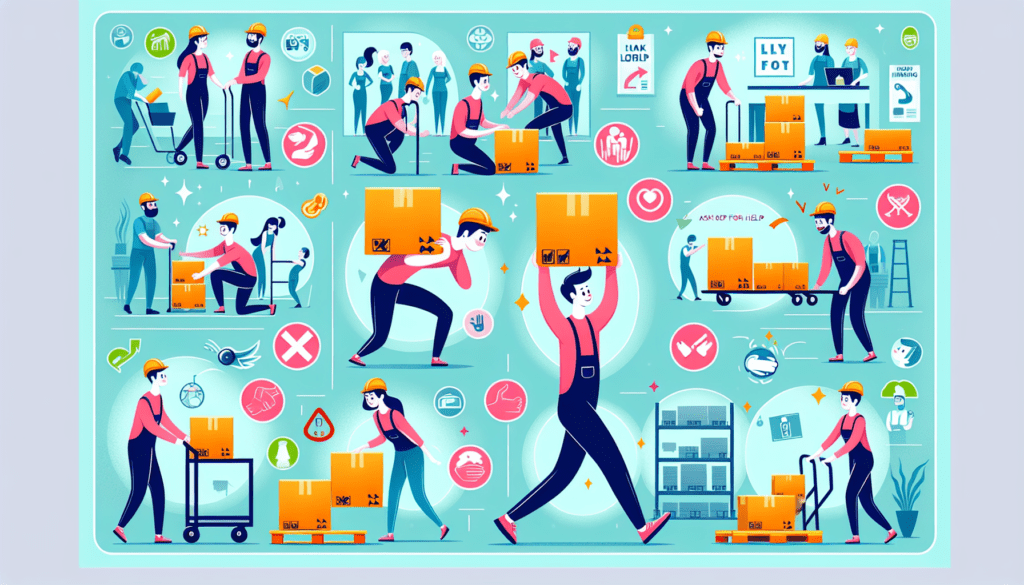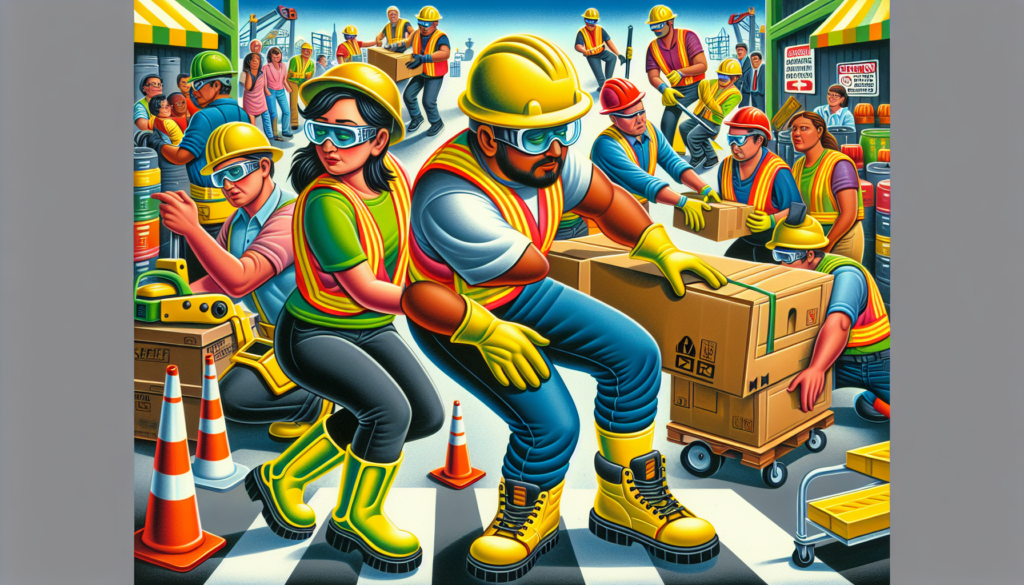- Key Takeaways
- Avoid Manual Handling When Possible
- Proper Planning Before Lifting
- Using Lifting Aids
- Safe Lifting Techniques
- Maintaining Good Posture
- Importance of Firm Grip
- Assessing the Work Environment
- Personal Protective Equipment (PPE)
- Risk Assessment Procedures
- Taking Breaks and Resting
- Training and Education
- Summary
- Frequently Asked Questions
In order to safeguard against injuries in the workplace and uphold safety standards, it is essential to become proficient in manual handling techniques. The content within this article offers practical guidance for securely lifting, transporting, and shifting burdens. Learn strategies designed to shield oneself while enhancing productivity during routine handling activities.
Key Takeaways
- Minimise manual handling tasks using automation and proper planning to reduce injury risks.
- Employ safe lifting techniques, such as keeping the load close and using your legs, to prevent injuries during manual handling.
- Conduct thorough risk assessments and provide regular training to ensure safe manual handling practices and proper use of Personal Protective Equipment (PPE).
Avoid Manual Handling When Possible

A fundamental aspect of maintaining safety in the workplace is minimising manual handling tasks where possible. Employers are encouraged to seek out alternatives for manual handling activities, aiming to lower the incidence of related injuries. Prior to engaging in lifting or other such tasks, one should consider whether there are more efficient methods available that could accomplish the same goal without manually transporting items. The implementation of automated systems not only increases productivity but also plays a significant role in decreasing injury risks.
In scenarios where automation does not present itself as a viable solution, it’s important to assess if objects truly require manual movement or lifting. Even slight modifications within a workspace or utilising devices designed for assistance can contribute significantly toward creating safer conditions at work. Performing risk assessments serves as an essential process, enabling hazard identification and permitting appropriate protective measures against potential dangers associated with these physical undertakings.
If eliminating all aspects of manual labor proves impossible, ensuring proper techniques are employed along with personal protective equipment and tools specifically engineered for aiding lift operations becomes crucially important—this preventive strategy aims towards averting harm while fostering an ethos centered on safety awareness among staff members.
Ultimately, striving diligently to minimise exposure hazards arising from incidents related directly to carrying out manual handling duties stands paramount. Consistently scrutinising task necessities remains the initial step toward achieving this objective effectively.
Proper Planning Before Lifting
It’s critical to carefully prepare for safe manual handling operations. Assess the details of your lifting task beforehand, including determining the requirements and strategising your approach. This thorough preparation reduces risk factors and facilitates secure job completion. Employing a TILE assessment—Task, Individual, Load, Environment—is beneficial in scrutinising every aspect associated with the manual handling task.
Take into account factors such as how heavy the load is, how far it must be carried, and at what height it should be lifted or placed down. Splitting heavier loads into smaller sections that are easier to manage can lessen the chance of sustaining an injury. It’s also important to make sure there are no obstructions along your path before commencing with lifting activities so as to decrease accident potential and streamline the operation.
Engaging in discussions with peers about handling strategies promotes awareness among everyone involved regarding safety procedures related to lifting tasks. By coordinating effectively on this front not only helps in averting injuries, but also boosts overall effectiveness and productivity within working routines.
Using Lifting Aids

The use of lifting aids is critical in the realm of manual handling, as they considerably mitigate risks associated with manual lifting injuries. Such mechanical devices, including lifts, jacks, trolleys and barrows, enhance safety by facilitating the secure movement of loads while minimising physical stress on workers. For instance, employing a sack trolley for transporting bulky cartons greatly surpasses the efficiency and safety margins compared to manually bearing them.
To choose fitting aids for lifting tasks requires an attentive evaluation concerning both task-specific elements and individual worker requirements. It’s essential that equipment selected for handling purposes be well-maintained and complemented with comprehensive training for employees. The combination of impeccably kept gear and skillfully instructed staff establishes a fundamental pillar supporting occupational welfare.
Incorporation of these instruments designed to aid in handling permits jobs involving lifting to proceed without undue strain or risk, ensuring actions are carried out seamlessly while prioritising personnel security against potential mishaps stemming from material moving activities. By weaving such assists into everyday operations, not only does one shield themselves but also contributes towards sculpting a working domain characterised by heightened efficacy coupled with reinforced protective measures against harm.
Safe Lifting Techniques

If the process of manual handling is unavoidable, it’s essential to employ secure lifting techniques. Ensuring the load stays near your waist promotes equilibrium and command over the item you’re moving. Execute movements with smoothness and refrain from abrupt motions that could heighten the likelihood of injury. Should precise placement be required, set down the weight before making adjustments.
Refrain from rotating or making sudden moves when engaging in lifting activities. A consistent and even lift can significantly reduce potential harm while also optimising effectiveness in handling tasks.
Below are outlined strategies intended to refine your capacity for safe manual transport by employing proper form and motion, particularly focusing on keeping loads close to prevent unnecessary twisting during lifts—all aimed at safeguarding against injuries and improving operational control throughout various stages of handling objects manually.
Maintain a Stable Position
Ensuring a stable position is vital when performing manual handling to safely lift objects. To achieve this, spread your feet slightly in front of the other to improve balance. This not only creates a firm base but also aids in maintaining control and stability throughout the lifting process.
Achieving control over the load while reducing the risk of injury hinges on adopting an appropriate stance during manual tasks. Placing your feet wide apart with one foot ahead can bolster equilibrium significantly, facilitating the safer execution of these duties and aiding you in attaining the desired position for effective handling practices.
Use Your Legs, Not Your Back
It is essential to use your legs rather than your back when lifting to safeguard against strain. Maintaining a straight back while bending at the knees and avoiding any twisting motions can prevent injuries and promote secure load management.
Employing correct handling techniques, which include using the strength of your legs by bending at the knees, significantly reduces the risk of incurring back injuries. It’s important to recognise that your legs possess greater strength compared to your back, so leveraging them will not only protect you but also enhance the efficiency of lifting tasks.
Keep the Load Close to Your Body
It is crucial to maintain the load near your body for better control and to lessen the stress on your back and arms. Ensure that the heaviest portion of what you’re carrying is positioned close to you, which will enhance control. By adopting this approach, you can decrease strain and increase your efficiency in handling the load.
Embracing the load close to your torso proves more beneficial than merely holding it firmly with your hands alone. Holding the object closer to your waist heightens stability while diminishing the chances of injury. Employing this straightforward but effective method can markedly elevate performance in tasks requiring manual handling.
Maintaining Good Posture
Maintaining proper posture is essential when performing manual handling tasks to ensure safety. Ensuring that your shoulders are level and aligned, as well as keeping the head raised and vision forward rather than downward at the load, can significantly reduce stress on the back and neck muscles.
To diminish the chance of injuries while lifting, it’s important to steer clear of twisting one’s body. Instead, use your feet to pivot during a lift operation. It is advisable to start by slightly bending the knees along with the hips and back before initiating a lift in order to mitigate risks associated with manual handling activities.
Assessing risk factors such as posture requirements, how far away from you the load will be carried or lifted, repetition frequency, the weight of materials being moved around, intrinsic characteristics of said loads against environmental aspects within which work occurs alongside workers’ individual physical abilities mustn’t be overlooked either because good postural habits are critical for preventing injury whilst guaranteeing both efficient execution plus adherence towards occupational health standards concerning labour-intensive roles/tasks involving significant amounts bodily manipulation (e.g., moving objects manually).
Importance of Firm Grip
Securing a firm grip on the object you are moving is crucial for preventing it from slipping and for maintaining control over it. For safe and efficient manual handling, employing a hooked grip when shifting loads is advisable. To Protect your hands during lifting tasks, consider wearing gloves.
During the course of carrying an object, if there’s a need to adjust your hold on it, either do so cautiously or put down the load before altering your grip to prevent mishaps. Sustaining a strong grasp not only bolsters control but also greatly diminishes the risk of sustaining injuries. This fundamental yet essential strategy plays an important role in ensuring safety across various manual handling activities.
Assessing the Work Environment
It is essential to evaluate the work setting when it comes to manual handling in order to identify potential hazards. Uneven flooring, slopes, and obscured corners should be surveyed as they can increase the risk of harm. Clearing any obstacles after walking the intended path prior to lifting is crucial for maintaining a secure route.
Minimising steps, inclines, or movements that involve twisting and turning during lifting operations is key for safety. By thoroughly assessing and modifying the work environment where necessary, you effectively diminish the likelihood of mishaps and injuries associated with manual handling tasks, promoting both safety and efficiency within the workplace.
Personal Protective Equipment (PPE)

The use of Personal Protective Equipment (PPE) is crucial for the safety of workers performing manual handling tasks. Gloves serve to shield hands from injuries such as burns, while protective footwear, including steel-toe boots, protects the feet from harm due to objects that may fall on them.
Eye protection like goggles is essential in guarding against potential hazards that can arise when dealing with breakable materials. By equipping workers with proper PPE, their risk of sustaining injuries is greatly reduced and it promotes a secure environment for these manual operations. The implementation of appropriate personal protective equipment notably elevates the level of safety associated with carrying out manual handling duties.
Risk Assessment Procedures
Procedures for assessing risks are critical in maintaining safety during tasks that involve manual handling. When evaluating potential dangers, the load’s characteristics, including its temperature, sharpness or slipperiness, must be taken into account. It is also important to consider the workers’ physical capabilities and health background to ascertain risks associated with manual handling.
Environmental aspects such as confined spaces, insufficient lighting, and severe temperatures can influence the safety of those involved in manual handling tasks. Involving employees and gathering their input during risk assessments can yield significant information about challenges related to manual handling.
By conducting comprehensive risk assessments, all possible perils are recognised and mitigated effectively, ensuring employee protection against hazards arising from these types of activities.
Identifying Potential Hazards
The initial phase in the risk assessment process involves pinpointing potential hazards. Risks associated with manual handling take into account factors such as the qualities of the load, personal abilities, and specifics of the task at hand. A higher level of risk is introduced by loads that are either hot to touch, have sharp edges or tend to slip easily. These necessitate extra safety measures.
When detecting hazards during this evaluation stage, it’s crucial also to review any existing control measures that are already in place. This comprehensive identification enables a more accurate analysis of risks and facilitates crafting effective strategies for their reduction. Adopting this preventive method promotes a work environment where safety is significantly enhanced for all involved parties.
Evaluating Risks
Upon identifying potential hazards, assess the corresponding risks. It is essential to document a proper risk assessment that captures the necessary measures to diminish these risks to a tolerable degree. Ensuring responsibility, this assessment needs documentation and should be allocated for execution.
Utilise instruments like MAC, V-MAC, RAPP, and ART to appraise an assortment of manual handling tasks. These resources aid in ordering risk control initiatives derived from the results of evaluations.
Efficiently analysing risks facilitates crafting specific plans aimed at curtailing the chances of sustaining injuries during manual handling activities.
Implementing Control Measures
The adoption of control strategies is vital when it comes to manual handling, aiming to minimise the risk of injury. Protective gear for individuals, commonly known as Personal Protective Equipment (PPE), serves as a significant method of control that safeguards workers against possible dangers. The choice of PPE must be tailored to match the particular tasks involved in manual handling, ensuring optimal safety and efficacy.
It is critical for enhancing workplace safety during manual handling activities that suitable measures are taken, which encompass utilising personal protective equipment. Through such implementations designed to manage risks effectively, the likelihood of sustaining injuries can be drastically reduced, fostering a more secure environment for those engaged in these types of operations.
Taking Breaks and Resting
It is essential to take periodic breaks and rest in order to mitigate fatigue and decrease the likelihood of sustaining injuries related to manual handling. In accordance with UK regulations, individuals who work more than six hours daily are entitled to a continuous break lasting 20 minutes. Such intermissions aid in preserving vigour levels, which is crucial for workers’ ability to execute their duties securely.
Should you need a pause during the process of transporting a load, it’s recommended that you place it on an elevated surface, such as a table or bench positioned at waist level. If exhaustion sets in while moving an object, modifying your hold on it and taking time off from carrying it can help prevent physical harm. Instituting routine breaks plays an indispensable role in upholding both safety standards and operational efficiency when engaging in tasks that involve manual handling.
Training and Education

Employees who perform manual handling tasks should receive frequent instruction in the proper techniques for lifting. Those employed across various industries, including retail, construction, manufacturing and healthcare, must be educated in the correct methods of manual handling. It is vital that any health and safety training initiative puts an emphasis on manual handling right from the start to guarantee that participants grasp crucial safety strategies immediately.
Effective training requires hands-on demonstrations to mitigate unsafe practices during handling. Regular evaluation of how well this training translates into practice is essential to ensure employees consistently employ secure methods when performing their duties manually. Tailoring this instruction to align with individual job functions can help maintain adherence over time.
Deploying visible checklists can act as a constant reminder of what was learned during these sessions and reinforce proper manual handling protocols amongst team members.
Summary
To recapitulate, it is essential to become proficient in the methods of manual handling to both boost safety and increase effectiveness within the workplace. The likelihood of sustaining injuries can be substantially diminished through strategies such as minimising direct manual handling where possible, meticulous planning of tasks, utilising aids for lifting, and adopting correct techniques for safely lifting items. It’s important to always maintain a proper posture while ensuring a secure grip on objects during these processes. Assessing potential hazards within the working area also plays a critical role.
It’s worth noting that incorporating periodic breaks into your routine, using appropriate personal protective equipment (PPE), and participating in continuous training are imperative measures for preserving high levels of safety amid tasks requiring manual handling. By instilling these practices effectively into daily operations, we forge not only an environment with heightened productivity but also one with superior safeguarding against the perils associated with manual handling. Henceforth, let us solidify our commitment towards prioritising preventative measures — thus shielding ourselves and fellow team members from any adverse incidents tied to manually managing materials or goods.


